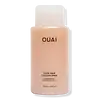What's inside
What's inside
 Key Ingredients
Key Ingredients

No key ingredients
 Benefits
Benefits

 Concerns
Concerns

 Ingredients Side-by-side
Ingredients Side-by-side

Water
Skin ConditioningSodium C14-16 Olefin Sulfonate
CleansingCocamidopropyl Betaine
CleansingSodium Methyl Cocoyl Taurate
CleansingCocamide Mipa
EmulsifyingGlycol Distearate
EmollientParfum
MaskingCetrimonium Chloride
AntimicrobialPanthenol
Skin ConditioningHydrolyzed Keratin
HumectantAvena Sativa Peptide
Skin ConditioningButyrospermum Parkii Butter
Skin ConditioningAlthaea Officinalis Root Extract
Skin ConditioningPersea Gratissima Oil
Skin ConditioningGlycerin
HumectantHydroxypropyl Guar Hydroxypropyltrimonium Chloride
PEG-150 Distearate
EmulsifyingSodium Lauroyl Glycinate
CleansingAmodimethicone
C11-15 Pareth-7
EmulsifyingLaureth-9
EmulsifyingTrideceth-12
EmulsifyingPolyquaternium-7
Cocoglucosides Hydroxypropyltrimonium Chloride
CleansingAcrylates Copolymer
Sodium Chloride
MaskingSodium Hydroxide
BufferingTetrasodium EDTA
Disodium EDTA
Citric Acid
BufferingPEG-200 Hydrogenated Glyceryl Palmate
CleansingPEG-7 Glyceryl Cocoate
EmulsifyingCaprylyl Glycol
EmollientBenzoic Acid
MaskingPotassium Sorbate
PreservativePhenoxyethanol
PreservativeSodium Benzoate
MaskingBenzyl Alcohol
PerfumingBenzyl Salicylate
PerfumingLimonene
PerfumingHexyl Cinnamal
PerfumingCI 14700
Cosmetic ColorantCI 15985
Cosmetic ColorantWater, Sodium C14-16 Olefin Sulfonate, Cocamidopropyl Betaine, Sodium Methyl Cocoyl Taurate, Cocamide Mipa, Glycol Distearate, Parfum, Cetrimonium Chloride, Panthenol, Hydrolyzed Keratin, Avena Sativa Peptide, Butyrospermum Parkii Butter, Althaea Officinalis Root Extract, Persea Gratissima Oil, Glycerin, Hydroxypropyl Guar Hydroxypropyltrimonium Chloride, PEG-150 Distearate, Sodium Lauroyl Glycinate, Amodimethicone, C11-15 Pareth-7, Laureth-9, Trideceth-12, Polyquaternium-7, Cocoglucosides Hydroxypropyltrimonium Chloride, Acrylates Copolymer, Sodium Chloride, Sodium Hydroxide, Tetrasodium EDTA, Disodium EDTA, Citric Acid, PEG-200 Hydrogenated Glyceryl Palmate, PEG-7 Glyceryl Cocoate, Caprylyl Glycol, Benzoic Acid, Potassium Sorbate, Phenoxyethanol, Sodium Benzoate, Benzyl Alcohol, Benzyl Salicylate, Limonene, Hexyl Cinnamal, CI 14700, CI 15985
 Reviews
Reviews

Ingredients Explained
These ingredients are found in both products.
Ingredients higher up in an ingredient list are typically present in a larger amount.
Parfum is a catch-all term for an ingredient or more that is used to give a scent to products.
Also called "fragrance", this ingredient can be a blend of hundreds of chemicals or plant oils. This means every product with "fragrance" or "parfum" in the ingredients list is a different mixture.
For instance, Habanolide is a proprietary trade name for a specific aroma chemical. When used as a fragrance ingredient in cosmetics, most aroma chemicals fall under the broad labeling category of “FRAGRANCE” or “PARFUM” according to EU and US regulations.
The term 'parfum' or 'fragrance' is not regulated in many countries. In many cases, it is up to the brand to define this term.
For instance, many brands choose to label themselves as "fragrance-free" because they are not using synthetic fragrances. However, their products may still contain ingredients such as essential oils that are considered a fragrance by INCI standards.
One example is Calendula flower extract. Calendula is an essential oil that still imparts a scent or 'fragrance'.
Depending on the blend, the ingredients in the mixture can cause allergies and sensitivities on the skin. Some ingredients that are known EU allergens include linalool and citronellol.
Parfum can also be used to mask or cover an unpleasant scent.
The bottom line is: not all fragrances/parfum/ingredients are created equally. If you are worried about fragrances, we recommend taking a closer look at an ingredient. And of course, we always recommend speaking with a professional.
Learn more about Parfum